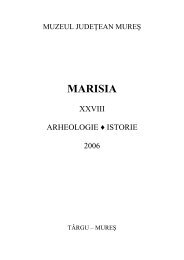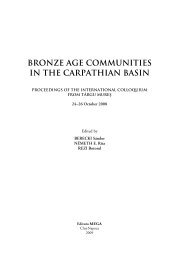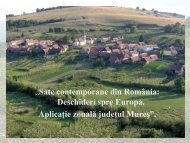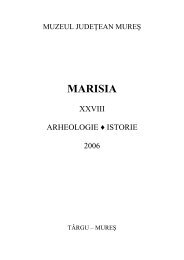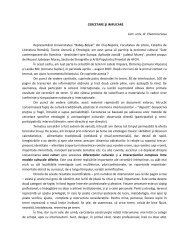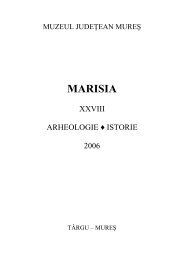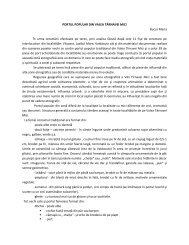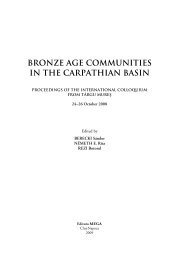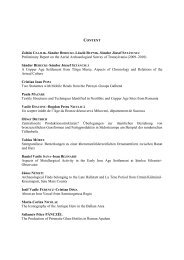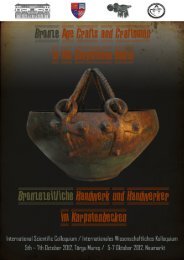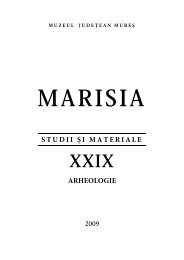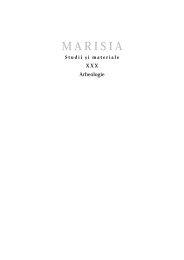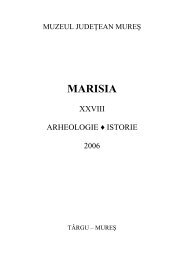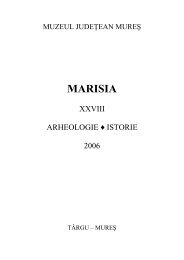A New Brick Kiln Discovered in the Roman Settlement from Cristești
A New Brick Kiln Discovered in the Roman Settlement from Cristești
A New Brick Kiln Discovered in the Roman Settlement from Cristești
Create successful ePaper yourself
Turn your PDF publications into a flip-book with our unique Google optimized e-Paper software.
Studii şi materiale
Executive editor<br />
Zoltán SOÓS<br />
Volume editor<br />
Sándor BERECKI<br />
Front cover:<br />
The fibula <strong>from</strong> Suseni (Photo: B. Rezi)<br />
Back cover:<br />
The brick kiln <strong>from</strong> <strong>Cristești</strong>, Mureş County (Photo: C. D. Crișan & D. Cioată)<br />
Correspondence:<br />
Muzeul Judeţean Mureș<br />
CP 85<br />
str. Mărăști nr. 8A, 540328<br />
Târgu Mureș, România<br />
ISSN 1221-0943
MUZEUL JUDEŢEAN MUREŞ<br />
<br />
STUDII ŞI MATERIALE<br />
<br />
ARHEOLOGIE<br />
Târgu Mureş<br />
2010
PREVIOUS VOLUMES<br />
Studii şi Materiale I, 1965 (Şti<strong>in</strong>ţele Naturii, Istorie, Etnografie, Muzeologie)<br />
Studii şi Materiale II, 1967 (Şti<strong>in</strong>ţele Naturii, Istorie, Muzeologie)<br />
Studii şi Materiale III–IV, 1972 (Şti<strong>in</strong>ţele Naturii, Istorie, Muzeologie)<br />
Marisia V, 1975 (Arheologie, Istorie, Etnografie)<br />
Marisia VI, 1976 (Arheologie, Istorie, Etnografie)<br />
Marisia VII, 1977 (Arheologie, Istorie, Etnografie)<br />
Marisia VIII, 1978 (Arheologie, Istorie, Etnografie)<br />
Marisia IX, 1979 (Arheologie, Istorie, Etnografie)<br />
Marisia X, 1980 (Arheologie, Istorie, Etnografie)<br />
Marisia XI–XII, 1981–1982 (Arheologie, Istorie, Etnografie)<br />
Marisia XI–XII, 1983, Fascicola 1 (Studia Scientiarium Naturae)<br />
Marisia XIII–XIV, 1984 (Arheologie, Istorie, Etnografie)<br />
Marisia XV–XXII, 1985–1992 (Arheologie, Istorie, Etnografie, Etnotoponimie)<br />
Marisia XXIII–XXIV, 1994 (Arheologie, Istorie, Etnografie)<br />
Marisia XXIII–XXIV, 1995, Fascicola 2 (Studia Scientiarium Naturae)<br />
Marisia XXV, 1996 (Arheologie, Istorie)<br />
Marisia XXV, 1996, Fascicola 1 (Etnografie, Artă, Artă populară)<br />
Marisia XXV, 1997 (Studia Scientiarium Naturae)<br />
Marisia XXVI, 2000 (Arheologie, Istorie)<br />
Marisia XXVI, 2000, Fascicola 2 (Etnografie, Artă, Artă populară)<br />
Marisia XXVI, 2000, Fascicola 4 (Studia Scientiarium Naturae)<br />
Marisia XXVII, 2003 (Arheologie, Istorie)<br />
Marisia XXVII, 2003, Fascicola 2 (Etnografie, Artă, Artă populară)<br />
Marisia XXVIII, 2005, Fascicola 2 (Etnografie, Artă, Artă populară)<br />
Marisia XXVIII, 2006 (Arheologie, Istorie)<br />
Marisia XXIX, 2009 (Arheologie)<br />
Marisia XXIX, 2009 (Istorie)<br />
Marisia XXIX, 2009 (Etnografie)
CONTENT<br />
ARTICLES<br />
Áldor Csaba BALÁZS<br />
The Coţofeni Site <strong>from</strong> Ș<strong>in</strong>cai–Cetatea Păgânilor (Mureş County). The 1996–1997 Campaigns ........ 7<br />
Laura DIETRICH<br />
„Du bist, was du ißt“. Zu den Kochsitten der Wietenberg- und der Noua-Kultur ............................... 25<br />
Oliver DIETRICH<br />
E<strong>in</strong>e Knochenpfeife der Noua-Kultur aus Rotbav–La Pârâuţ? ................................................................ 41<br />
Botond REZI<br />
The Bronze Hoard <strong>from</strong> Sâmbriaş (Mureş County) ................................................................................. 45<br />
Sándor BERECKI<br />
Two La Tène Bronze Discs <strong>from</strong> Târgu Mureş, Transylvania .................................................................. 69<br />
Szilamér Péter PÁNCZÉL<br />
Dom<strong>in</strong>a and Dom<strong>in</strong>us <strong>from</strong> Cristeşti (Mureş County) ........................................................................... 77<br />
Nicoleta MAN–Daniel CIOATĂ–Coralia CRIȘAN<br />
A <strong>New</strong> <strong>Brick</strong> <strong>Kiln</strong> <strong>Discovered</strong> <strong>in</strong> <strong>the</strong> <strong>Roman</strong> <strong>Settlement</strong> <strong>from</strong> <strong>Cristești</strong> ................................................ 85<br />
Nicoleta MAN<br />
Art and Religions on <strong>the</strong> Eastern Part of Dacia (With Special Regard to <strong>the</strong> Upper Mureş Area) .... 95<br />
Gregor DÖHNER–Manuel FIEDLER–Constanze HÖPKEN–Christoph MERZENICH–<br />
Szilamér Péter PÁNCZÉL–Veit STÜRMER–Zsolt VASÁROS<br />
Forschungen im Kastell von Porolissum. Bericht zur Kampagne 2009 ............................................... 115<br />
Lóránt VASS<br />
Women <strong>in</strong> a Man’s World? Female Related Artefacts <strong>from</strong> <strong>the</strong> Camps of Dacia ................................ 127<br />
István FÁBIÁN<br />
Some Considerations Concern<strong>in</strong>g <strong>the</strong> Weapons dur<strong>in</strong>g <strong>the</strong> Great Migrations<br />
<strong>in</strong> <strong>the</strong> North Danubian Area (4 th –7 th Centuries AD) .............................................................................. 153<br />
Keve LÁSZLÓ<br />
The Early Medieval Pottery <strong>from</strong> Sângeorgiu de Mureș–<strong>Roman</strong> Catholic Cemetery<br />
(Mureş County) ........................................................................................................................................... 159
Zalán GYŐRFI–Szilárd Sándor GÁL<br />
Archaeological Data Regard<strong>in</strong>g <strong>the</strong> Medieval History of <strong>the</strong> Unitarian Church <strong>in</strong> Adămuş<br />
(Mureş County) ........................................................................................................................................... 171<br />
Zoltán SOÓS–Szilárd Sándor GÁL<br />
Burials <strong>in</strong> <strong>the</strong> Târgu Mureș Franciscan Friary. A Fourteenth Century Burial with Diadem............. 187<br />
Ünige BENCZE<br />
Late Medieval Graphite Ware <strong>in</strong> <strong>the</strong> Târgu Mureș Franciscan Friary<br />
and <strong>the</strong> Study of Imported Pottery <strong>in</strong> Transylvania ................................................................................ 205<br />
Beatrice CIUTĂ<br />
Archaeobotanical Analyses Carried on Macro-Rema<strong>in</strong>s <strong>from</strong> Târgu Mureș–Franciscan Friary.<br />
(2007 campaign) .......................................................................................................................................... 213<br />
BOOK REVIEW<br />
Bartosiewicz László–Gál Erika–Kováts István (Ed.), Csontvázak a szekrényből<br />
(Skeletons <strong>from</strong> <strong>the</strong> Cupboard), Budapest, 2009 (by Erzsébet BERENDI) .......................................... 219<br />
Gáll Erw<strong>in</strong>–Gergely Balázs, Kolozsvár születése. Régészeti adatok a város 10–13. századi történetéhez<br />
(The Birth of Cluj. Historical Data related to <strong>the</strong> city’s history <strong>from</strong> <strong>the</strong> 10 th to <strong>the</strong> 13 th century),<br />
Kolozsvár, 2009 (by Keve LÁSZLÓ) ........................................................................................................ 221<br />
ABBREVIATIONS .................................................................................................................................... 223
A NEW BRICK KILN DISCOVERED<br />
IN THE ROMAN SETTLEMENT<br />
FROM CRISTEŞTI<br />
Nicoleta Man–Daniel Cioată–Coralia Crişan<br />
Mureş County Museum, Târgu Mureş<br />
Keywords: brick kiln, stamped tiles, <strong>Roman</strong> Age<br />
The <strong>Roman</strong> settlement <strong>from</strong> Cristeşti is known as one of <strong>the</strong> greatest centres of ceramic<br />
production <strong>in</strong> <strong>Roman</strong> Dacia. 1 The pottery manufactured here is outstand<strong>in</strong>g as quantity and<br />
also due to its wide range of shapes, which implicitly po<strong>in</strong>t to <strong>the</strong> various functionalities it once<br />
had. The 6 furnaces, toge<strong>the</strong>r with <strong>the</strong> abundant pottery material and <strong>the</strong> numerous moulds<br />
discovered <strong>in</strong> time, 2 reveal a real local pottery ‘<strong>in</strong>dustry’ which covered not only <strong>the</strong> needs of <strong>the</strong><br />
settlement, but spread out to <strong>the</strong> neighbour<strong>in</strong>g zone, too.<br />
In 2007, <strong>the</strong> archaeologists <strong>from</strong> <strong>the</strong> Mureş County Museum suspended <strong>the</strong> ongo<strong>in</strong>g<br />
works for <strong>the</strong> construction of a car park, less than 1 km far <strong>from</strong> <strong>the</strong> <strong>Roman</strong> settlement <strong>from</strong><br />
Cristeşti (Pl. 1/1). The <strong>in</strong>tervention led to <strong>the</strong> rescue of a brick kiln, contemporary to <strong>the</strong> settlement.<br />
3 This dat<strong>in</strong>g is confirmed by <strong>the</strong> technique used to build it (with analogies <strong>in</strong> <strong>the</strong> <strong>Roman</strong><br />
world, as proved below) and <strong>the</strong> materials found <strong>in</strong> association with it. It was recovered almost<br />
entirely, apart <strong>from</strong> <strong>the</strong> front wall and <strong>the</strong> praefurnium. The upper part of <strong>the</strong> kiln had been<br />
destroyed <strong>in</strong> ancient times, after <strong>the</strong> retrieval of <strong>the</strong> last batch of bricks and <strong>the</strong> abandonment of<br />
<strong>the</strong> <strong>in</strong>stallation.<br />
At <strong>the</strong> moment we noticed <strong>the</strong> rema<strong>in</strong>s of <strong>the</strong> kiln, <strong>the</strong> north-eastern part of <strong>the</strong> hill<br />
had already been levelled, to create a flat surface for <strong>the</strong> construction so <strong>the</strong> forepart and <strong>the</strong><br />
praefurnium of <strong>the</strong> kiln were dug by <strong>the</strong> mach<strong>in</strong>es. In <strong>the</strong> excavated soil we did not f<strong>in</strong>d many<br />
traces of pottery or o<strong>the</strong>r <strong>in</strong>stallations, which could have been destroyed before our arrival.<br />
1<br />
Floca 1937, 12; Ferenczi 1929, 216–217; Filimon 1940, 3–8; Popescu 1956, 119; Protase, D–Zrínyi A.–Dankanics A.,<br />
Raport prelim<strong>in</strong>ar asupra săpăturilor de la Cristeşti, manuscript <strong>in</strong> <strong>the</strong> archive of MCM; Zrínyi 1977, 94, fig. XLV;<br />
Husar–Man 1996, 22–23.<br />
2<br />
Pop 1994, 42.<br />
3<br />
The literature about <strong>the</strong> pottery kilns <strong>from</strong> <strong>the</strong> <strong>Roman</strong> prov<strong>in</strong>ces and also <strong>the</strong> ones extra prov<strong>in</strong>ciam is generous;<br />
<strong>the</strong>refore we would like to enumerate only <strong>the</strong> more popular and quoted works that regard situations closer to our<br />
discovery. Berciu 1949, 180–188; Protase–Dănilă 1965, 583–587; Petre 1968, 133–146; Popilian 1969, 167–169;<br />
Floca et al. 1970, 38; Mărghitan 1971, 531–535; Duhamel 1975, 12–20; Henn<strong>in</strong>g 1977, 190–193; Gudea 1978,<br />
135–147; Căt<strong>in</strong>aş 1980, 81–84; Benea 1982, 22–40; Lipovan 1983, 301–312; Alicu 1984, 467–470; Le Ny 1988;<br />
Gudea 1989, 194–198; Mitrofan 1991, 173–200; Mitrofan 1993; Moga, 1996, 9–16; Muşeţeanu 1996, 17–22; Matei<br />
1997, 367–400; Popilian 1997, 7–21; Ardevan 2001, 319–329; Gaiu 2001, 161–198.
86<br />
N. Man–D. Cioată–C. Crişan<br />
To recuperate as much stratigraphical <strong>in</strong>formation and as many elements of <strong>the</strong> kiln as<br />
possible, two surfaces were opened. The first one, C1 (6 × 6.14 m) was traced to determ<strong>in</strong>e <strong>the</strong><br />
configuration of <strong>the</strong> above part of <strong>the</strong> kiln and <strong>the</strong> possible rema<strong>in</strong>s of <strong>the</strong> brick fir<strong>in</strong>g room or<br />
maybe <strong>the</strong> roof. Its orientation was <strong>the</strong> same as <strong>the</strong> one of <strong>the</strong> kiln, namely NE–SV. In <strong>the</strong> front<br />
of <strong>the</strong> kiln, a second surface, C2 was opened, with smaller dimensions (2.80 × 4.40 m), with <strong>the</strong><br />
purpose of recover<strong>in</strong>g rema<strong>in</strong><strong>in</strong>g parts of <strong>the</strong> praefurnium. In <strong>the</strong> south-eastern corner of C1, on<br />
<strong>the</strong> level belong<strong>in</strong>g to <strong>the</strong> brick fir<strong>in</strong>g room, 5 tiles with tegular <strong>in</strong>scription ALA I BOSP (Ala I<br />
Bosporanorum) and some fragmentary <strong>Roman</strong> pottery were found – out of which <strong>the</strong> 5 tiles were<br />
positioned <strong>in</strong> situ.<br />
The description of <strong>the</strong> kiln (Fig. 1)<br />
The place chosen for <strong>the</strong> kiln to be constructed was <strong>the</strong> north-eastern slope of a hill, protected<br />
<strong>from</strong> <strong>the</strong> w<strong>in</strong>ds, to be able to control easier <strong>the</strong> atmosphere <strong>in</strong>side. The rectangular hole that was<br />
dug <strong>in</strong> <strong>the</strong> sterile clay for <strong>the</strong> kiln to be<br />
built had 3.80 × 4.10 m. Additionally,<br />
it had a front extension for <strong>the</strong><br />
praefurnium, of cca 1.40 × 1.80 m,<br />
which broadened towards <strong>the</strong> end<br />
of it (we weren’t able to determ<strong>in</strong>e<br />
<strong>the</strong> entire shape, s<strong>in</strong>ce it no longer<br />
existed when we found <strong>the</strong> kiln). The<br />
shape of <strong>the</strong> kiln was rectangular, with<br />
exterior dimensions of 2.80 × 2.70 m<br />
(Pl. 1/3). A 40 cm to 1 m thick layer<br />
of brown clay was strongly settled<br />
<br />
<br />
<br />
<br />
<br />
<br />
between <strong>the</strong> marg<strong>in</strong>s of <strong>the</strong> hole and<br />
<strong>the</strong> walls of <strong>the</strong> kiln. The walls were<br />
built <strong>from</strong> a s<strong>in</strong>gle layer of sun-dried<br />
bricks, 38 cm long, 18 to 20 cm wide<br />
and 8 cm thick. They were preserved<br />
up to 1.80 m <strong>in</strong> <strong>the</strong> highest po<strong>in</strong>t of<br />
<strong>the</strong> kiln rema<strong>in</strong>s.<br />
The walls of <strong>the</strong> praefurnium (Pl. 1/4) were probably made <strong>in</strong> <strong>the</strong> same way as <strong>the</strong> ones of<br />
<strong>the</strong> kiln form<strong>in</strong>g a vaulted structure and <strong>the</strong> floor was rounded downwards. The total length kept<br />
<strong>from</strong> this fore part is of 1.20 m, measured <strong>from</strong> <strong>the</strong> exterior wall (<strong>the</strong> rema<strong>in</strong>s) of <strong>the</strong> brick kiln.<br />
The upper part was not preserved. Several bricks were arranged horizontally at <strong>the</strong> mouth of <strong>the</strong><br />
praefurnium.<br />
The ignition room was entirely built <strong>in</strong>to <strong>the</strong> hole dug <strong>in</strong> <strong>the</strong> hill. Like <strong>the</strong> majority of <strong>the</strong><br />
kilns discovered <strong>in</strong> <strong>Roman</strong> Dacia and not only, <strong>the</strong> grid that separated <strong>the</strong> ignition room <strong>from</strong><br />
<strong>the</strong> brick fir<strong>in</strong>g room was susta<strong>in</strong>ed by arches. Between <strong>the</strong>se (3 <strong>in</strong> number) <strong>the</strong>re were <strong>the</strong> spaces<br />
that conducted <strong>the</strong> hot air towards <strong>the</strong> orifices of <strong>the</strong> grid and upwards, <strong>in</strong> <strong>the</strong> material room. The<br />
arches were made up of sun-dried bricks, bound with clay. The dimensions of <strong>the</strong> bricks differed<br />
(as related to <strong>the</strong>ir place <strong>in</strong> <strong>the</strong> structure of <strong>the</strong> arch): 32 to 78 cm long and 24 to 28 wide, with
A <strong>New</strong> <strong>Brick</strong> <strong>Kiln</strong> <strong>Discovered</strong> <strong>in</strong> <strong>the</strong> <strong>Roman</strong> <strong>Settlement</strong> <strong>from</strong> Cristeşti 87<br />
a thickness of 8 to 10 cm. The arches became progressively narrower <strong>from</strong> <strong>the</strong> exterior to <strong>the</strong><br />
<strong>in</strong>terior. The first one (<strong>the</strong> one close to <strong>the</strong> praefurnium) had a height of 96 m (measured <strong>from</strong> <strong>the</strong><br />
floor of <strong>the</strong> ignition room) and an open<strong>in</strong>g at its base of 98 cm. The follow<strong>in</strong>g one was 1 m high<br />
and 70 cm wide at <strong>the</strong> base and <strong>the</strong> last one was 98 cm high and 52 cm wide. Consequently, <strong>the</strong><br />
arches were built <strong>from</strong> radially laid bricks (Pl. 2/5) which provided <strong>the</strong> grid (toge<strong>the</strong>r with <strong>the</strong><br />
entire load it might have supported) with a very good susta<strong>in</strong>ability. Inside <strong>the</strong> ignition room,<br />
<strong>the</strong> open<strong>in</strong>g of <strong>the</strong> arches formed a central channel, 2.65 m long. From this channel, six o<strong>the</strong>rs,<br />
three on each side, formed <strong>the</strong> <strong>in</strong>terstitial air-conduct<strong>in</strong>g spaces, hav<strong>in</strong>g each up to 40 cm width<br />
(Pl. 2/4). In <strong>the</strong> typology submitted by Le Ny, <strong>the</strong> correspond<strong>in</strong>g type of air-conduct<strong>in</strong>g system is<br />
number 4, 4 form<strong>in</strong>g an oblique l<strong>in</strong>e that l<strong>in</strong>ks directly <strong>the</strong> floor of <strong>the</strong> kiln to <strong>the</strong> walls.<br />
In <strong>the</strong> order of <strong>the</strong> elements that shaped <strong>the</strong> ignition room, <strong>the</strong> first (<strong>from</strong> <strong>the</strong> front<br />
to <strong>the</strong> back) was an <strong>in</strong>terstitial space, which corresponded at <strong>the</strong> grid level to <strong>the</strong> orifices that<br />
conducted <strong>the</strong> hot air, followed by an arch, correspond<strong>in</strong>g at <strong>the</strong> same grid level to a l<strong>in</strong>e of bricks<br />
laid horizontally (Pl. 2/6) and so on, count<strong>in</strong>g <strong>in</strong> all 4 <strong>in</strong>terstitial spaces and 3 arches.<br />
As mentioned above, <strong>the</strong> elements of this room were all made of sun-dried brick, bound<br />
with clay (successive strata of clay<strong>in</strong>g). The clay layer reached as much as 10 cm, and it was<br />
extremely slagged, due to <strong>the</strong> very high temperatures atta<strong>in</strong>ed <strong>in</strong>side. The floor was also clayed and<br />
preserved many traces of charcoal. While empty<strong>in</strong>g <strong>the</strong> ignition room, we came across two dark<br />
brown pr<strong>in</strong>ts (<strong>in</strong> <strong>the</strong> soil) with a 9 cm diameter <strong>in</strong> each <strong>in</strong>terstitial space <strong>from</strong> <strong>the</strong> back part of <strong>the</strong><br />
kiln, which prove <strong>the</strong> existence of some support<strong>in</strong>g posts, horizontally set, two <strong>in</strong> each <strong>in</strong>terstitial<br />
space (Pl. 2/3). They were set <strong>the</strong>re dur<strong>in</strong>g <strong>the</strong> build<strong>in</strong>g process of <strong>the</strong> <strong>in</strong>stallation and were only<br />
visible <strong>in</strong> <strong>the</strong> last channels of heath transmission, where <strong>the</strong> actual fire did not reach. Both posts<br />
were used to stand aga<strong>in</strong>st soil pressure. Their importance is relevant, especially s<strong>in</strong>ce <strong>the</strong> back wall<br />
remarkably curved towards <strong>the</strong> <strong>in</strong>terior of <strong>the</strong> <strong>in</strong>stallation, precisely because of <strong>the</strong> earth pressure.<br />
The grid (Fig. 2; Pl. 2/2) had 2.40 × 2.40 m, 40 orifices, grouped <strong>in</strong> pears, <strong>in</strong> 4 rows of 10<br />
each. Every pear of orifices was made of one brick laid perpendicular to o<strong>the</strong>r two ones and at<br />
<strong>the</strong> same time parallel with <strong>the</strong> l<strong>in</strong>e<br />
<br />
of bricks that covered <strong>the</strong> arches.<br />
Thus, <strong>the</strong>ir orig<strong>in</strong>al shape was a<br />
<br />
rectangular one, hav<strong>in</strong>g average<br />
<br />
dimensions of 10 × 15 cm. On<br />
<strong>the</strong> three surfaces <strong>from</strong> above <strong>the</strong><br />
arches bricks were laid horizontally.<br />
Unlike <strong>the</strong> arches, for which<br />
large sized bricks were used, <strong>the</strong><br />
ones <strong>from</strong> <strong>the</strong> orifices and <strong>the</strong> ones<br />
<strong>from</strong> above <strong>the</strong> arches had up to<br />
40 cm <strong>in</strong> length, 30 cm <strong>in</strong> width,<br />
and no more than 12 cm thickness.<br />
The platform was clayed<br />
<br />
with several layers: <strong>the</strong> first one,<br />
applied after <strong>the</strong> bricks were laid (this layer had f<strong>in</strong>ger made grooves, to optimize <strong>the</strong> adherence<br />
of <strong>the</strong> subsequent layer), <strong>the</strong> second one was <strong>the</strong> one on which <strong>the</strong> first batch of bricks was laid<br />
4<br />
Le Ny 1988, 55, fig. 33.
88<br />
N. Man–D. Cioată–C. Crişan<br />
and <strong>the</strong> third one was a later adjustment. This latter one did not cover <strong>the</strong> entire surface of <strong>the</strong><br />
grid; it needed to fill <strong>the</strong> cracks that appeared due to <strong>the</strong> usage of <strong>the</strong> kiln and <strong>the</strong> high temperatures<br />
reached <strong>in</strong>side. Because of <strong>the</strong>se layers, <strong>the</strong> aspect of <strong>the</strong> heath transmission holes was<br />
round and not rectangular, with an average diameter of 12 cm. The existence of only one layer<br />
of restoration of <strong>the</strong> grid might lead to <strong>the</strong> conclusion that it was only used a few times. This fact<br />
is pretty much clear, s<strong>in</strong>ce except for <strong>the</strong> parts lost because of <strong>the</strong> excavator, <strong>the</strong> general state of<br />
preservation is very good.<br />
The brick fir<strong>in</strong>g room was preserved up to 76 cm. Its walls were <strong>the</strong> upward extension of<br />
<strong>the</strong> ignition room’s walls. In <strong>the</strong> process of clear<strong>in</strong>g <strong>the</strong> grid, we found pieces of <strong>the</strong> eastern wall<br />
crushed on <strong>the</strong> floor of this room.<br />
Given <strong>the</strong> general features of <strong>the</strong> <strong>in</strong>stallation, we consider that it was dest<strong>in</strong>ed to function<br />
for many batches of bricks. As it was constructed straight <strong>in</strong>to <strong>the</strong> ground, <strong>the</strong> access <strong>in</strong> <strong>the</strong> brick<br />
fir<strong>in</strong>g room was made <strong>from</strong> <strong>the</strong> upper part. Probably <strong>the</strong> batch, after be<strong>in</strong>g stacked on <strong>the</strong> grid,<br />
was covered with a layer of clay and had holes or some k<strong>in</strong>d of chimney, that permitted <strong>the</strong> air<br />
to ventilate <strong>the</strong> room. The batch was fur<strong>the</strong>r more protected by a supplementary roof, as proved<br />
by <strong>the</strong> two post holes <strong>in</strong> <strong>the</strong> sou<strong>the</strong>rn part of <strong>the</strong> kiln (up, on <strong>the</strong> hill slope), with a diameter of<br />
10 cm, detected <strong>in</strong> <strong>the</strong> same archaeological layer.<br />
In <strong>the</strong> same area tiles, pieces of gutter tiles and pottery were found (Pl. 2/1; 3/2). The pottery<br />
fragments belonged to red coloured common use vessels. Most of <strong>the</strong>m are non-typical fragments,<br />
except <strong>from</strong> a fragment <strong>from</strong> to a medium sized bowl (rim diameter of 24 cm). It had a straight and<br />
rounded rim, curved walls and most probably annular bottom (this part is miss<strong>in</strong>g).<br />
Best represented is <strong>the</strong> tegular material: 5 tile fragments with <strong>the</strong> ALA I BOSP (Ala I<br />
Bosporanorum) stamp, several unstamped ones and fragments of gutter tiles. A typology of <strong>the</strong>se<br />
stamps has already been made by N. Gudea and A. Zírnyi 5 and we can assign <strong>the</strong> ones we found<br />
to <strong>the</strong> III rd type (Pl. 3). Unfortunately, it does not provide us with enough pieces of <strong>in</strong>formation<br />
to help us date this discovery more precisely.<br />
As it is widely acknowledged, <strong>the</strong> discovery of kilns – whe<strong>the</strong>r for produc<strong>in</strong>g construction<br />
materials or pottery with various functionalities – is <strong>the</strong> best proof that we are deal<strong>in</strong>g with a<br />
pottery workshop. Whenever <strong>the</strong>se kilns are <strong>in</strong> certa<strong>in</strong> archaeological connection with o<strong>the</strong>r<br />
complexes waste pits for scraps, f<strong>in</strong>ished products, characteristic tools, etc. we can undoubtedly<br />
discuss about genu<strong>in</strong>e workshops.<br />
About pottery workshops and kilns discovered at Cristeşti, only few data and<br />
descriptions are kept <strong>from</strong> <strong>the</strong> authors of <strong>the</strong> previous researches. Dur<strong>in</strong>g <strong>the</strong> excavations<br />
made by A. Filimon and Al. Ferenczi five kilns were discovered (three circular and two<br />
rectangular). A rectangular kiln was discovered <strong>in</strong> 1972 by A. Zrínyi. All <strong>the</strong> data that we have<br />
prove <strong>the</strong> fact that <strong>the</strong> roman kilns <strong>from</strong> Cristeşti produced only pottery and this is <strong>the</strong> only<br />
brick kiln discovered up to now. Probably most workshops were concentrated <strong>in</strong> one area of<br />
<strong>the</strong> settlement (like <strong>in</strong> o<strong>the</strong>r settlements with similar f<strong>in</strong>d<strong>in</strong>gs), 6 certa<strong>in</strong>ly close to <strong>the</strong> Mureş<br />
River. Also, archaeological discoveries <strong>from</strong> 2000, on <strong>the</strong> right bank of Mureş River, lead us to<br />
<strong>the</strong> hypo<strong>the</strong>sis that <strong>the</strong> settlement had an extended workshops area and an <strong>in</strong>habited area on<br />
that side of <strong>the</strong> river also.<br />
5<br />
Gudea–Zrínyi 1977, 223–232; Gudea–Zrínyi 1984, 51–58.<br />
6<br />
Protase–Dănilă 1965, 583–587; Floca et al. 1970, 14–16; Benea 1982, 22–40; Lipovan, 1984, 301–317; Mitrofan<br />
1993, 36; Pop 1994, 42; Moga 1996, 9–19; Muşeţeanu 1996, 17–22; Popilian 1997, 7–21; Ardevan 2001, 319–329.
A <strong>New</strong> <strong>Brick</strong> <strong>Kiln</strong> <strong>Discovered</strong> <strong>in</strong> <strong>the</strong> <strong>Roman</strong> <strong>Settlement</strong> <strong>from</strong> Cristeşti 89<br />
On account of <strong>the</strong> significant quantities of build<strong>in</strong>g materials discovered <strong>in</strong> time, we can<br />
conclude beyond any doubt that <strong>the</strong>re functioned a brickyard where <strong>the</strong>y produced <strong>the</strong> necessary<br />
construction materials for <strong>the</strong> camp and <strong>the</strong> vicus. 7<br />
This kiln is placed outside <strong>the</strong> area of <strong>the</strong> settlement, on a hill located about 1 km away<br />
<strong>from</strong> <strong>the</strong> sou<strong>the</strong>rn limit of <strong>the</strong> settlement. Interest<strong>in</strong>g is that although <strong>the</strong> whole surround<strong>in</strong>g<br />
area was levelled, no o<strong>the</strong>r kilns were found, or o<strong>the</strong>r auxiliary equipment necessary to produce<br />
ceramics, such as pits and <strong>the</strong> waste materials. This s<strong>in</strong>gular occurrence is a rarity <strong>in</strong> <strong>the</strong> <strong>Roman</strong><br />
world, especially s<strong>in</strong>ce <strong>the</strong> kiln was build for long time operation.<br />
Technically, <strong>the</strong> <strong>in</strong>stallation which is <strong>the</strong> subject of this study corresponds <strong>in</strong> <strong>the</strong> typology<br />
proposed by Françoise Le Ny to type IIE 8 of rectangular shaped kilns, with <strong>the</strong> observation<br />
that <strong>in</strong> our case <strong>the</strong> dimensions are slightly smaller. This type is met <strong>in</strong> <strong>Roman</strong> Dacia at Ulpia<br />
Traiana Sarmizegetusa 9 and Micia 10 or <strong>in</strong> Dobrouja at Garvăn. 11 The appearance of stamped<br />
bricks certified once more that <strong>the</strong>re used to be a roman camp at Cristeşti, still not located. No<br />
specific dat<strong>in</strong>g material was found so precise dat<strong>in</strong>g could not be established, but <strong>the</strong> discovery<br />
can undoubtedly be correlated with <strong>the</strong> <strong>Roman</strong> habitation level <strong>from</strong> <strong>the</strong> area, <strong>from</strong> <strong>the</strong> 2 nd –3 rd<br />
centuries AD. It must never<strong>the</strong>less be l<strong>in</strong>ked also with <strong>the</strong> presence of Ala I Bosporanorum <strong>in</strong><br />
<strong>the</strong> vic<strong>in</strong>ity, owed to <strong>the</strong> presence of <strong>the</strong> military stamps, but fur<strong>the</strong>r details will be provided by<br />
future archaeological research <strong>in</strong> <strong>the</strong> area.<br />
BIBLIOGRAPHY<br />
Alicu 1984<br />
Alicu, D., Două cuptoare de ars ţigle și cărămizi de la Ulpia Traiana<br />
Sarmizegetusa, ActaMN, XXI, 467–470.<br />
Ardevan 2001<br />
Ardevan, R., Cuptoare romane de la Napoca, IN: Studia archaeologica et<br />
historica Nicolao Gudea dicata. Omagiu Profesorului Nicolae Gudea la 60 de<br />
ani, Zalău, 319–329.<br />
Benea 1976 Benea D., Ofic<strong>in</strong>a militară de la Dierna (sec. III–IV), ActaMN, XIII, 205–<br />
214.<br />
Benea 1982<br />
Benea, D., Ateliere ceramice de la Tibiscum. Contribuţii la istoria atelierelor<br />
de ceramică d<strong>in</strong> SV Daciei, Potaissa, III, 22–40.<br />
Berciu 1949 Berciu, I., Descoperiri arheologice la Apulum, Apulum, III, 1947–1949,<br />
180–188.<br />
Căt<strong>in</strong>aș 1980 Căt<strong>in</strong>aș, A., Ceramica romană de la Potaissa–str. Cheii, Potaissa, II, 81–84.<br />
Duhamel 1975<br />
Duhamel, P., Les ateliers céramiques de la Gaule roma<strong>in</strong>e, IN: Les dossiers<br />
de l’archéologie, Paris, 9, 12–20.<br />
Ferenczi 1928<br />
Ferenczi Al., Dare de seamă asupra săpăturilor de la <strong>Cristești</strong>, ACMIT,<br />
1926–1928, 216–217.<br />
Filimon 1940<br />
Floca 1937<br />
Filimon, A., <strong>Cristești</strong> (Sangidava), extract <strong>from</strong> RPAN, II–IV.<br />
Floca, O., Colecţia arheologică a Muzeului de Arheologie și Etnografie a<br />
Palatului Culturii d<strong>in</strong> Târgu-Mureș, IN: Bulet<strong>in</strong>ul Muzeului Arheologic al<br />
Societăţii de istorie, Arheologie și etnografie d<strong>in</strong> Târgu-Mureș, nr. 1, Extras<br />
d<strong>in</strong> Gazeta Ilustrată, nr. 6–7.<br />
7<br />
Petolescu–Mărghitan 1974, 247–258; Benea 1976, 205–214; Moga 1976, 191–196.<br />
8<br />
Le Ny 1988, 41 and also fig. 20b and fig. 23 b/IIE.<br />
9<br />
Floca 1942, 430–440.<br />
10<br />
Floca et al. 1970, kiln nr. 1, 17–22.<br />
11<br />
Ştefan 1957, 339–344.
90<br />
N. Man–D. Cioată–C. Crişan<br />
Floca 1942 Floca, O., Der römische ziegelofen von Sarmizegetusa, Dacia, IX–X, 1941–<br />
1942, 430–440.<br />
Floca et al. 1970<br />
Floca, O.–Ferenczi Șt.–Mărghitan, L., Micia. Grupul de cuptoare romane<br />
pentru ars ceramică, Deva.<br />
Gaiu 2001<br />
Gaiu, C., Grupul de cuptoare de ars ceramică de la Ilișua, IN: Gaiu, C. (ed.),<br />
Ateliere și tehnici meșteșugărești, Contribuţii arheologice, Bistriţa, 161–198.<br />
Gudea 1978<br />
Gudea, N., Contribuţii la istoria economică a Daciei romane. Despre<br />
producţia ceramică, Apulum, XVI, 135–147.<br />
Gudea 1989<br />
Gudea, N., Porolissum. Un complex arheologic daco-roman la marg<strong>in</strong>ea<br />
Imperiului <strong>Roman</strong>, ActaMP, XIII, 194–198.<br />
Gudea–Zrínyi 1977 Gudea, N.–Zrínyi A., Contributions épigraphiques á l’histoire de la Ala I<br />
Bosporanorum, IN: Epigraphica (Travaux dédiés au VII e Congrès d’épigraphie<br />
grecque et lat<strong>in</strong>e), Constanţa, 223–232.<br />
Gudea–Zrínyi 1984 Gudea, N.–Zrínyi A., Contribuţii la istoria militară a Daciei romane. Ala I<br />
Gallorum et Bosporanorum, Marisia, XIII–XIV, 1983–1984, 51–58.<br />
Henn<strong>in</strong>g 1977<br />
Henn<strong>in</strong>g, J., Entwicklungstendenzen der Keramikproduction an der<br />
mittleren und unteren Donau im 1 Jahrtausend u. Z., ZA, 11, 190–193.<br />
Husar–Man 1996<br />
Husar, A.–Man, N., <strong>Roman</strong> rural settlement of Cristeşti, Marisia, XXV,<br />
21–35.<br />
Le Ny 1988<br />
Le Ny, F., Les fours de tuiliers gallo-roma<strong>in</strong>s, Méthodologie, ètude technologique,<br />
typologique et statistique. Chronologie, Documents d’archéologie française,<br />
12.<br />
Lipovan 1984<br />
Lipovan, I. T., Offic<strong>in</strong>a ceramistului Gaius Iulius Proculus la Ampelum,<br />
AIIA, XXVI, 1983–1984, 301–317.<br />
Matei 1997<br />
Matei, Al. V., Cuptoarele pentru ars ceramică cenușie ștampilată descoperite<br />
la Zalău, ActaMP, XXI, 367–400.<br />
Mărghitan 1971<br />
Mărghitan, L., Un cuptor d<strong>in</strong> centrul de ars obiecte ceramice recent<br />
descoperit la Micia, Apulum, IX, 531–535.<br />
Mitrofan 1991<br />
Mitrofan, I., Les recherches archéologiques dans la centre céramique de<br />
Micăsasa, RCRFA, XXIX–XXX, 173–200.<br />
Mitrofan 1993<br />
Mitrofan, I., Așezarea romană de la Micăsasa, PhD, Cluj.<br />
Moga 1996 Moga, V., Le centre de poterie antique d’Ampelum, RCRFA, 33, 9–19.<br />
Muşeţeanu 1996 Muşeţeanu, C., Les ateliers céramiques de Durostorum, RCRFA, 33, 17–22.<br />
Petolescu–Mărghitan 1976 Petolescu, C. C.– Mărghitan, L., Ţigle și cărămizi ștampilate d<strong>in</strong> <strong>the</strong>rmele<br />
de la Micia, MN, I, 247–258.<br />
Petre 1968 Petre, Gh. I., Cuptor de olar cu vase dacice și romane la Buridava, SCIV, 19,<br />
1, 133–146.<br />
Pop 1994<br />
Pop, C., Ateliere particulare de ceramică în Dacia <strong>Roman</strong>ă, RevBis, VIII,<br />
247–252.<br />
Popilian 1969<br />
Popilian, Gh., Două cuptoare de ars ţigle și cărămizi descoperite la Romula,<br />
RevMuz, 6, 2, 167–169.<br />
Popilian 1997<br />
Popilian, Gh., Les centres de production céramique d’Olténie, IN: Études sur<br />
la céramique roma<strong>in</strong>e et daco-roma<strong>in</strong>e de la Dacie et de la Mésie Inferieure,<br />
Timişoara, 7–21.<br />
Protase–Dănilă 1965 Protase, D.–Dănilă, Șt., Un cuptor roman de ars cărămizi la Orheiu Bistriţei,<br />
Apulum, V, 583–587.<br />
Ștefan 1957 Ștefan, Gh., Un cuptor roman de ars ţigle de la Garvăn, SCIV, VIII, 1–4,<br />
339–344.
A <strong>New</strong> <strong>Brick</strong> <strong>Kiln</strong> <strong>Discovered</strong> <strong>in</strong> <strong>the</strong> <strong>Roman</strong> <strong>Settlement</strong> <strong>from</strong> Cristeşti 91<br />
LIST OF FIGURES<br />
Fig. 1. The structural scheme of <strong>the</strong> kiln.<br />
Fig. 2. The structure of <strong>the</strong> grid as seen <strong>from</strong> above.<br />
LIST OF PLATES<br />
Pl. 1.<br />
Pl. 2.<br />
Pl. 3.<br />
1. The location of <strong>the</strong> <strong>Roman</strong> settlement (1) and of <strong>the</strong> brick kiln (2); 2. Front view of <strong>the</strong> kiln: <strong>the</strong><br />
state <strong>in</strong> which it was when discovered; 3. Front view of <strong>the</strong> kiln; 4. The praefurnium.<br />
1. <strong>Roman</strong> tiles <strong>in</strong> situ; 2.The grid and <strong>the</strong> fir<strong>in</strong>g room; 3. Traces of <strong>the</strong> wooden posts <strong>in</strong> <strong>the</strong> earth<br />
that filled <strong>the</strong> kiln; 4. The ignition room: <strong>the</strong> arches; 5. Section through <strong>the</strong> elements of <strong>the</strong> kiln; 6.<br />
Traces of <strong>the</strong> arches <strong>in</strong> <strong>the</strong> lateral walls.<br />
1. Stamped tiles; 2. Bowl.
92<br />
N. Man–D. Cioată–C. Crişan
A <strong>New</strong> <strong>Brick</strong> <strong>Kiln</strong> <strong>Discovered</strong> <strong>in</strong> <strong>the</strong> <strong>Roman</strong> <strong>Settlement</strong> <strong>from</strong> Cristeşti 93
94<br />
N. Man–D. Cioată–C. Crişan



